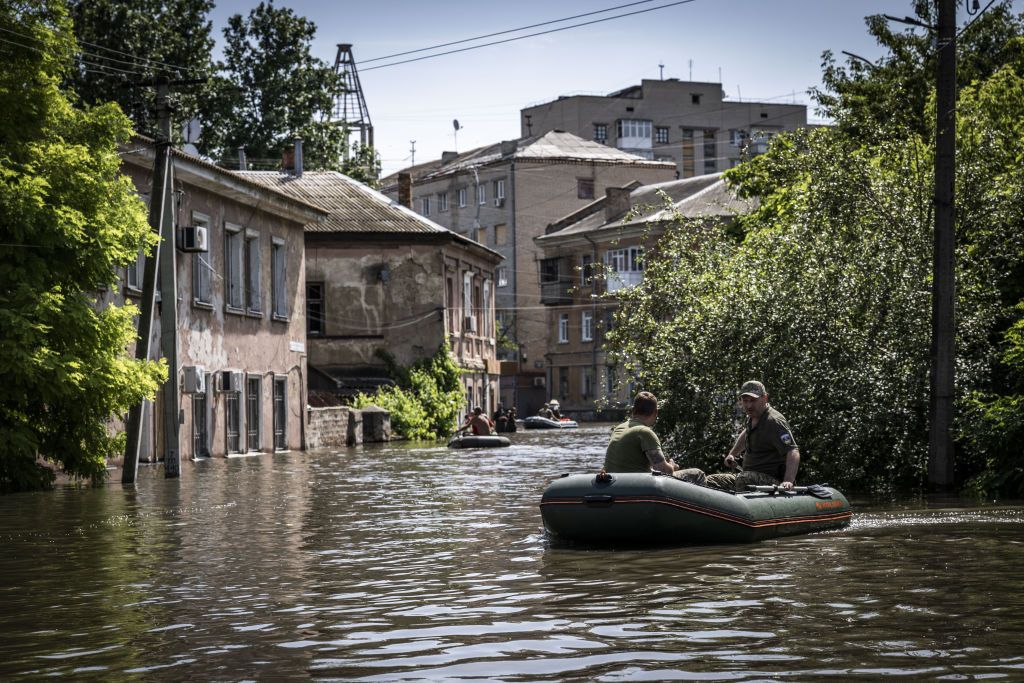Ukraine war latest: 30 settlements flooded after Kakhovka dam destruction; 10,000 hectares of farmland expected to submerge

Key developments on June 7:
- Dam explosion floods dozens of settlements in Kherson Oblast
- Over 10,000 hectares of farmland expected to be flooded in the south, ministry warns
- Risk of cholera after Kakhovka dam explosion, Health Ministry warns
- General Staff: Russian forces block evacuation routes from flooded occupied territories
- Ukraine has not yet launched counteroffensive, senior official says
- Defense Ministry: Ukrainian forces go on offensive near Bakhmut.
Water continues to spread after the June 6 Kakhovka dam explosion in the southern Ukrainian Kherson Oblast.
A humanitarian and ecological disaster unfolded when the Kakhovka Hydroelectric Power Plant’s dam collapsed in the early hours of June 6. Ukraine’s authorities said the Russian forces intentionally destroyed the dam, presumably to hinder a Ukrainian counteroffensive.
More than 1,900 people, including 103 children, were evacuated from southern Ukraine as of 11 p.m., the Interior Ministry reported.
Earlier in the day, Interior Minister Ihor Klymenko said that that emergency services and volunteers evacuated civilians from the city of Kherson, as well as Kherson and Mykolaiv oblasts.
“As of now, 30 settlements, including 20 in Ukraine-controlled territory and 10 in Russia-occupied area, are flooded,” Klymenko, who is in charge of the liquidation of the dam destruction’s consequences, said on national television.
Klymenko also said that the Russian forces are “not evacuating people” from the flooded occupied areas.
The General Staff of Ukraine’s Armed Forces reported in its evening update on June 7 that Russian troops in the occupied settlements of Kozachi Laheri in Kherson Oblast blocked all possible escape routes and banned civilian evacuation.
The authorities contacted the international organizations and are “developing a plan to do everything possible to ensure our citizens can save their lives and health,” Klymenko said.
Oleksandr Khorunzhyi, the State Emergency Service spokesperson, said the water level in Kherson has risen by approximately five meters.
Khorunzhyi said there is currently no information regarding any casualties due to the flooding.
Ukraine's agriculture, which has already sufferred severely due to Russia's war, faces further economic damage.
The Agriculture Ministry warned on June 7 that 10,000 hectares of arable land on the right bank of the Dnipro River in Kherson Oblast are expected to be flooded.
The “several times” bigger farmland area is expected to be flooded in the Russian-occupied territories, the ministry estimated.
The dam explosion also will affect the water supply of 31 irrigation systems of the fields in Dnipropetrovsk, Kherson, and Zaporizhzhia oblasts, where Ukraine harvested some 4 million metric tones of grain and oilseeds worth about $1.5 billion in 2021, according to the report.
The ministry said it would provide further details in the coming days after analyzing the imagery of the affected areas.
Risk of cholera
The flooding provoked by the Kakhovka dam explosion could cause cholera in the affected areas, Deputy Health Minister Ihor Kuzin said on June 7.
“We do not rule out cholera cases. The situation will become clear after the water level decreases,” Kuzin said on June 7, as cited by the Interfax-Ukraine news agency.
Cholera is a diarrheal illness caused by bacteria, typically transmitted through contaminated food or water. While some cases may be mild or asymptomatic, others can be severe and pose a life-threatening risk, according to the Centers for Disease Control and Prevention, the national public health agency of the U.S.
The healthcare official also said that clinics in the affected regions have stocks of drinking water for at least two days, urging locals against consuming dead fish.
At least 150 tons of machine oil have been released into the Dnipro River during the flooding.
The biodiversity of the region is also expected to be heavily impacted. Officials are already observing the death of local fish populations.
Tens of thousands of fish have died in Dnipropetrovsk Oblast after Russia's destruction of the Kakhovka dam the day before, the Health Ministry reported on June 7.
“The same situation may develop in the coming days in other affected regions,” the Health Ministry said.
The ministry also warned that fish might also begin to die in large numbers in Zaporizhzhia and Kherson oblasts in the next three to five days due to a sudden drop in water levels.
Counteroffensive
Secretary of the National Security and Defense Council Oleksii Danilov said in an interview with Reuters that Ukraine has not yet launched its counteroffensive, dismissing Russia’s claims of otherwise.
Dailov said that “everyone will see” when Ukraine starts its counteroffensive.
“When all this will begin, it will be decided by our military,” he said. “When we start the counteroffensive, everyone will know about it, they will see it.”
Danilov also said the Russian officials mistakenly interpreted local Ukrainian advances in certain areas as the beginning of a larger operation.
Ukraine is ready for the counteroffensive, President Volodymyr Zelensky said in an interview with the Wall Street Journal released on June 3.
Deputy Defense Minister Hanna Maliar reported on June 7 that Ukrainian forces went on the offensive near Bakhmut in Donetsk Oblast, making small advances in the area.
Land Forces Commander, Colonel General Oleksandr Syrskyi, said that Ukraine’s forces advanced on Russian flanks near Bakhmut, gaining ground.
The Russian regular army has been replacing the Wagner Group near Bakhmut after the mercenary outfit boss, Yevgeny Prigozhin, announced these troops would withdraw after claiming that Bakhmut had been captured on May 20.
Ukraine hasn’t formally admitted the claim.
While fighting around Bakhmut is still ongoing, the industrial city with a pre-war population of 73,000 has been turned into scorched earth after almost a year of intense fighting.
















